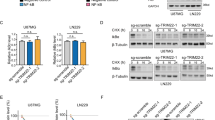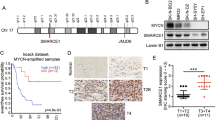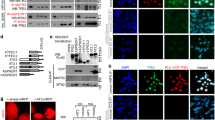Abstract
The signal transducer and activator of transcription 3 (STAT3) can be activated by the tyrosine kinase domain of the chimeric protein nucleophosmin/anaplastic lymphoma kinase (NPM/ALK), and has a pivotal role in mediating NPM/ALK-related malignant cell transformation. Although the role of STAT3 and wild-type NPM in oncogenesis has been extensively investigated, the relationship between both molecules in cancer remains poorly understood. In the present study, we first demonstrate that STAT3 phosphorylation at tyrosine 705 is accompanied by a concomitant increase in the expression level of NPM. Nuclear co-translocation of phosphorylated STAT3 with NPM can be triggered by interferon-alpha (IFN-α) stimulation of Jurkat cells and phosphorylated STAT3 co-localizes with NPM in cancer cells showing constitutive STAT3 activation. We further demonstrate that STAT3 phosphorylation can transcriptionally mediate NPM upregulation in IFN-α-stimulated Jurkat cells and is responsible for maintaining its expression in cancer cells showing constitutive STAT3 activation. Inhibition of STAT3 phosphorylation or knockdown of NPM expression abrogates their simultaneous transnuclear movements. Finally, we found evidence for a physical interaction between NPM and STAT3 in conditions of STAT3 activation. In conclusion, NPM is a downstream effector of the STAT3 signaling, and can facilitate the nuclear entry of phosphorylated STAT3. These observations might open novel opportunities for targeting the STAT3 pathway in cancer.
This is a preview of subscription content, access via your institution
Access options
Subscribe to this journal
Receive 50 print issues and online access
$259.00 per year
only $5.18 per issue
Buy this article
- Purchase on Springer Link
- Instant access to full article PDF
Prices may be subject to local taxes which are calculated during checkout





Similar content being viewed by others
References
Darnell JE Jr . Transcription factors as targets for cancer therapy. Nat Rev Cancer. 2002; 2: 740–749.
Yu H, Jove R The STATs of cancer–new molecular targets come of age. Nat Rev Cancer 2004; 4: 97–105.
Zhong Z, Wen Z, Darnell JE Jr . Stat3: a STAT family member activated by tyrosine phosphorylation in response to epidermal growth factor and interleukin-6. Science 1994; 264: 95–98.
Darnell JE Jr, Kerr IM, Stark GR . Jak-STAT pathways and transcriptional activation in response to IFNs and other extracellular signaling proteins. Science 1994; 264: 1415–1421.
Kujawski M, Kortylewski M, Lee H, Herrmann A, Kay H, Yu H . Stat3 mediates myeloid cell-dependent tumor angiogenesis in mice. J Clin Invest 2008; 118: 3367–3377.
Yu H, Pardoll D, Jove R . STATs in cancer inflammation and immunity: a leading role for STAT3. Nat Rev Cancer 2009; 9: 798–809.
Mantovani A, Allavena P, Sica A, Balkwill F . Cancer-related inflammation. Nature 2008; 454: 436–444.
Grisendi S, Mecucci C, Falini B, Pandolfi PP . Nucleophosmin and cancer. Nat Rev Cancer 2006; 6: 493–505.
Colombo E, Bonetti P, Lazzerini Denchi E, Martinelli P, Zamponi R, Marine JC et al. Nucleophosmin Is Required for DNA Integrity and p19Arf Protein Stability. Mol Cell Biol 2005; 25: 8874–8886.
Brady SN, Maggi LB Jr, Winkeler CL, Toso EA, Gwinn AS, Pelletier CL et al. Nucleophosmin protein expression level, but not threonine 198 phosphorylation, is essential in growth and proliferation. Oncogene 2009; 28: 3209–3220.
Kurki S, Peltonen K, Latonen L, Kiviharju TM, Ojala PM, Meek D et al. Nucleolar protein NPM interacts with HDM2 and protects tumor suppressor protein p53 from HDM2-mediated degradation. Cancer Cell 2004; 5: 465–475.
Colombo E, Marine J-C, Danovi D, Falini B, Pelicci PG . Nucleophosmin regulates the stability and transcriptional activity of p53. Nat Cell Biol 2002; 4: 529–533.
Szebeni A, Olson MO . Nucleolar protein B23 has molecular chaperone activities. Protein Sci 1999; 8: 905–912.
Wang W, Budhu A, Forgues M, Wang XW . Temporal and spatial control of nucleophosmin by the Ran-Crm1 complex in centrosome duplication. Nat Cell Biol 2005; 7: 823–830.
Szebeni A, Herrera JE, Olson MO . Interaction of nucleolar protein B23 with peptides related to nuclear localization signals. Biochemistry 1995; 34: 8037–8042.
Vassiliou GS, Cooper JL, Rad R, Li J, Rice S, Uren A et al. Mutant nucleophosmin and cooperating pathways drive leukemia initiation and progression in mice. Nat Genet 2011; 43: 470–475.
Falini B, Bolli N, Liso A, Martelli MP, Mannucci R, Pileri S et al. Altered nucleophosmin transport in acute myeloid leukaemia with mutated NPM1: molecular basis and clinical implications. Leukemia 2009; 23: 1731–1743.
Marzec M, Zhang Q, Goradia A, Raghunath PN, Liu X, Paessler M et al. Oncogenic kinase NPM/ALK induces through STAT3 expression of immunosuppressive protein CD274 (PD-L1, B7-H1). Proc Natl Acad Sci USA 2008; 105: 20852–20857.
Kasprzycka M, Marzec M, Liu X, Zhang Q, Wasik MA . Nucleophosmin/anaplastic lymphoma kinase (NPM/ALK) oncoprotein induces the T regulatory cell phenotype by activating STAT3. Proc Natl Acad Sci USA 2006; 103: 9964–9969.
Morris SW, Kirstein MN, Valentine MB, Dittmer K, Shapiro DN, Look AT et al. Fusion of a kinase gene, ALK, to a nucleolar protein gene, NPM, in non-Hodgkin's lymphoma. Science 1995; 267: 316–317.
Zamo A, Chiarle R, Piva R, Howes J, Fan Y, Chilosi M et al. Anaplastic lymphoma kinase (ALK) activates Stat3 and protects hematopoietic cells from cell death. Oncogene 2002; 21: 1038–1047.
Su L, David M . Distinct mechanisms of STAT phosphorylation via the interferon-alpha/beta receptor. Selective inhibition of STAT3 and STAT5 by piceatannol. J Biol Chem 2000; 275: 12661–12666.
Berishaj M, Gao S, Ahmed S, Leslie K, Al-Ahmadie H, Gerald WL et al. Stat3 is tyrosine-phosphorylated through the interleukin-6/glycoprotein 130/Janus kinase pathway in breast cancer. Breast Cancer Res 2007; 9: R32.
Schust J, Sperl B, Hollis A, Mayer TU, Berg T . Stattic: a small-molecule inhibitor of STAT3 activation and dimerization. Chem Biol 2006; 13: 1235–1242.
Bhat UG, Jagadeeswaran R, Halasi M, Gartel AL . Nucleophosmin interacts with FOXM1 and modulates the level and localization of FOXM1 in human cancer cells. J Biol Chem 2011; 286: 41425–41433.
Kelley JB, Talley AM, Spencer A, Gioeli D, Paschal BM . Karyopherin alpha7 (KPNA7), a divergent member of the importin alpha family of nuclear import receptors. BMC Cell Biol 2010; 11: 63.
Liu L, McBride KM, Reich NC . STAT3 nuclear import is independent of tyrosine phosphorylation and mediated by importin-alpha3. Proc Natl Acad Sci USA 2005; 102: 8150–8155.
Chan PK, Chan FY, Morris SW, Xie Z . Isolation and characterization of the human nucleophosmin/B23 (NPM) gene: identification of the YY1 binding site at the 5' enhancer region. Nucleic Acids Res 1997; 25: 1225–1232.
Vallania F, Schiavone D, Dewilde S, Pupo E, Garbay S, Calogero R et al. Genome-wide discovery of functional transcription factor binding sites by comparative genomics: the case of Stat3. Proc Natl Acad Sci USA 2009; 106: 5117–5122.
Lee H, Deng J, Kujawski M, Yang C, Liu Y, Herrmann A et al. STAT3-induced S1PR1 expression is crucial for persistent STAT3 activation in tumors. Nat Med 2010; 16: 1421–1428.
Zheng P, Zhong Q, Xiong Q, Yang M, Zhang J, Li C et al. QUICK identification and SPR validation of signal transducers and activators of transcription 3 (Stat3) interacting proteins. J Proteomics 2012; 75: 1055–1066.
Pranada AL, Metz S, Herrmann A, Heinrich PC, Muller-Newen G . Real time analysis of STAT3 nucleocytoplasmic shuttling. J Biol Chem 2004; 279: 15114–15123.
Herrmann A, Sommer U, Pranada AL, Giese B, Kuster A, Haan S et al. STAT3 is enriched in nuclear bodies. J Cell Sci 2004; 117 (Pt 2): 339–349.
Valdez BC, Perlaky L, Henning D, Saijo Y, Chan PK, Busch H . Identification of the nuclear and nucleolar localization signals of the protein p120. Interaction with translocation protein B23. J Biol Chem 1994; 269: 23776–23783.
Li YP, Busch RK, Valdez BC, Busch H . C23 interacts with B23, a putative nucleolar-localization-signal-binding protein. Eur J Biochem 1996; 237: 153–158.
Szebeni A, Mehrotra B, Baumann A, Adam SA, Wingfield PT, Olson MO . Nucleolar protein B23 stimulates nuclear import of the HIV-1 Rev protein and NLS-conjugated albumin. Biochemistry 1997; 36: 3941–3949.
Fankhauser C, Izaurralde E, Adachi Y, Wingfield P, Laemmli UK . Specific complex of human immunodeficiency virus type 1 rev and nucleolar B23 proteins: dissociation by the Rev response element. Mol Cell Biol 1991; 11: 2567–2575.
Swaminathan V, Kishore AH, Febitha KK, Kundu TK . Human histone chaperone nucleophosmin enhances acetylation-dependent chromatin transcription. Mol Cell Biol 2005; 25: 7534–7545.
Cimica V, Chen HC, Iyer JK, Reich NC . Dynamics of the STAT3 transcription factor: nuclear import dependent on Ran and importin-beta1. PLoS One 2011; 6: e20188.
Leslie K, Gao SP, Berishaj M, Podsypanina K, Ho H, Ivashkiv L et al. Differential interleukin-6/Stat3 signaling as a function of cellular context mediates Ras-induced transformation. Breast Cancer Res 2010; 12: R80.
Li J, Zhang X, Sejas DP, Bagby GC, Pang Q . Hypoxia-induced nucleophosmin protects cell death through inhibition of p53. J Biol Chem 2004; 279: 41275–41279.
Swoboda RK, Somasundaram R, Caputo L, Berencsi K, von Franzke P, Taylor DD et al. Nucleophosmin is recognized by a cytotoxic T cell line derived from a rectal carcinoma patient. Int J Cancer 2010; 127: 1124–1130.
Acknowledgements
We gratefully acknowledge technical and administrative assistance from Dr Erik Teugels, Dr Zhihai Peng, Eddy Himpe, Bill Roskams, Geert Stangé, Petra Roman, Elsy Vaeremans, Cleo Goyvaerts. We sincerely thank Dr Jacqueline Bromberg, Dr Dorothee Herlyn, Dr Pravin Sehgal, Dr Qishen Pang for their provision of shSTAT3, shNPM, GFP-STAT3 Y705A, and NPM promoter vectors. We also express our gratitude to Dr Georges De Bruyne and Dr Peter de Witte for providing MDA-MB-231, MDA-MB-435 and MDA-MB-468 cell lines. This work was supported by the Stichting Tegen Kanker Belgium, FWO-Vlaanderen (FWOAL335, FWOAL455 and FWOWO35) and the VUB (OZR1144). ZR is a Ph. D student supported by Chinese Scholarship Council (CSC)-VUB joint scholarship. JLA and KB are postdoctoral fellows of the Foundation of Scientific Research Flanders (FWO-V).
Author information
Authors and Affiliations
Corresponding author
Ethics declarations
Competing interests
The authors declare no conflict of interest.
Additional information
Supplementary Information accompanies this paper on the Oncogene website
Supplementary information
Rights and permissions
About this article
Cite this article
Ren, Z., Aerts, J., Pen, J. et al. Phosphorylated STAT3 physically interacts with NPM and transcriptionally enhances its expression in cancer. Oncogene 34, 1650–1657 (2015). https://doi.org/10.1038/onc.2014.109
Received:
Revised:
Accepted:
Published:
Issue Date:
DOI: https://doi.org/10.1038/onc.2014.109
This article is cited by
-
Phosphorylated STAT5 regulates p53 expression via BRCA1/BARD1-NPM1 and MDM2
Cell Death & Disease (2016)



